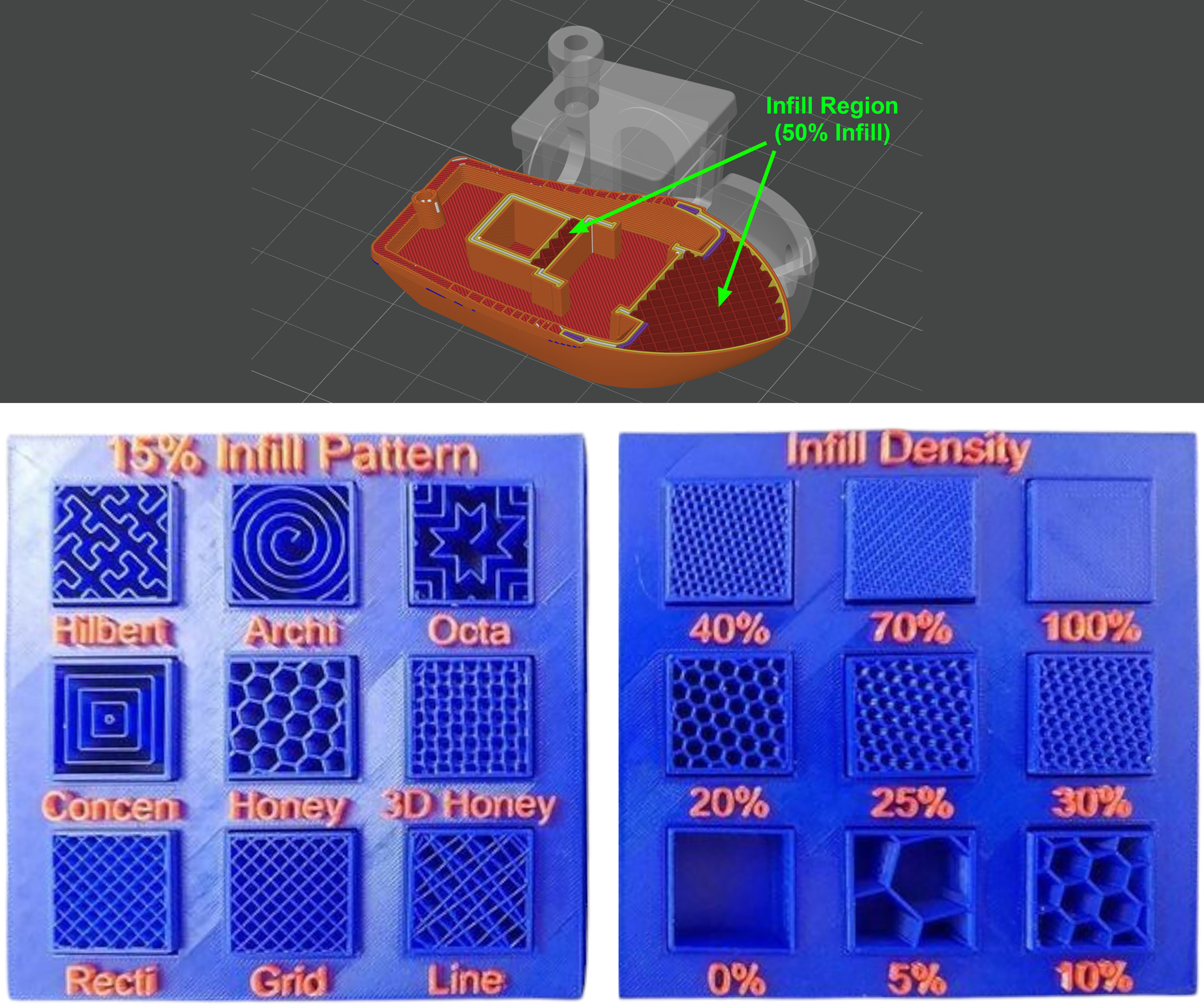
3D Printing জগতে "Infill Density" একটি গুরুত্বপূর্ণ শব্দ, যা প্রতিটি প্রিন্টের গুণগতমান, কতটা মজবুত, ওজন, সময় এবং খরচে সরাসরি প্রভাব ফেলে। ইনফিল ডেনসিটি বলতে বোঝানো হয়, একটি প্রিন্টের ভিতরে কতটা অংশ ফাঁপা এবং কত পার্সেন্ট সলিড থাকবে — অর্থাৎ এককথায় অভ্যন্তরীণ কাঠামোর ঘনত্ব। এটি সাধারণত শতাংশে প্রকাশ করা হয়। মনে রাখতে হবে Infill প্রয়োগ হয় মডেলের মধ্যে থাকা সলিড অংশে। অর্থাৎ, যেমন একটি সম্পূর্ণ সলিড Cube প্রিন্ট করতে এর ভিতরের সলিড অংশের স্টাকচারটি আসলেই কত পার্সেন্ট সলিড হবে তা নির্ধারিত হয় Infill Percent এর দ্বারা এবং এই সলিড অংশটি যদি 100% Infill না হয় তবে তা পূরনের জন্য কি ধরনের প্যাটার্ন বা কাঠামো ব্যবহার করা হবে তা নির্ধারিত হয় Infill pattern এর দ্বারা।
-
০% ইনফিল মানে প্রিন্টের মডেলটির আভ্যন্তরীন অংশ একেবারেই ফাঁপা।
-
১০০% ইনফিল মানে প্রিন্টের মডেলটির আভ্যন্তরিন কাঠামো সম্পূর্ণ সলিড
ইনফিল ডেনসিটি কিভাবে প্রিন্টকে প্রভাবিত করে?
| প্রভাব | বিস্তারিত |
|---|---|
| মজবুত | ইনফিল যত বেশি হবে, প্রিন্ট তত বেশি মজবুত হবে। |
| প্রিন্ট টাইম | ইনফিল এর পার্সেন্ট বেশি হওয়া মানে প্রিন্টে বেশি সময় লাগা। |
| ম্যাটেরিয়াল খরচ | বেশি ইনফিল মানে বেশি ফিলামেন্ট খরচ। |
| ওজন | ইনফিল যত বেশি হবে, প্রিন্টেড মডেলের ওজনও তত বেশি হবে। |
ইনফিল প্যাটার্ন: শুধু ঘনত্ব নয়, গঠনও গুরুত্বপূর্ণ
শুধু ইনফিলের শতাংশ নয়, ইনফিল প্যাটার্নও (অর্থাৎ ভেতরের গঠনের ধরন) গুরুত্বপূর্ণ। নিচে কিছু জনপ্রিয় ইনফিল প্যাটার্ন:
-
Grid (গ্রিড): সহজ এবং দ্রুত প্রিন্ট হয়, হালকা মডেলের জন্য ভালো।
-
Honeycomb (হানিকম্ব): মৌচাকের মতো ছাঁদ, শক্ত ও ফিলামেন্ট-সাশ্রয়ী।
-
Gyroid (জাইরয়েড): খুব মজবুত এবং নান্দনিক, বিশেষ করে ফাংশনাল পার্টে।
-
Cubic (কিউবিক): ত্রি-মাত্রিক গঠন, ভারসাম্যপূর্ণ শক্তি প্রদান করে।
কোন প্রয়োজনে কত ইনফিল ডেনসিটি ব্যবহার করবেন?
| ব্যবহার | ইনফিল ডেনসিটি | মন্তব্য |
|---|---|---|
| প্রদর্শনযোগ্য মডেল (Display models) | ৫% - ১৫% | বাহ্যিক সৌন্দর্য দরকার, শক্তি নয়। |
| খেলনা, হালকা যন্ত্রাংশ | ২০% - ৩০% | ব্যালান্স রাখা হয় সময় ও শক্তির মধ্যে। |
| ফাংশনাল পার্ট, স্ক্রু ফিটিং | ৫০% - ৭০% | টেকসই ও মজবুত হওয়া দরকার। |
| উচ্চ চাপ বা লোড সহনীয় অংশ | ৮০% - ১০০% | সম্পূর্ণ সলিড গঠন প্রয়োজন। |
টিপস: স্মার্টলি ইনফিল নির্বাচন করবেন কীভাবে?
-
শেল ও ওয়ালের সাথে ভারসাম্য রাখুন: শুধু ইনফিল বাড়িয়ে লাভ নেই, প্রিন্টের ওয়াল (outer shell) শক্ত না হলে ভিতরের ঘনত্ব কাজে লাগবে না।
-
ইনফিল থেকে উপরের লেয়ার ভেঙে পড়ছে? তাহলে টপ লেয়ারের সংখ্যা বাড়ান (Top Layers ≥ 4 রাখুন)।
-
চলন্ত অংশ হলে (যেমন জয়েন্ট বা গিয়ার): ৪০%-৬০% ইনফিল ভালো ফল দেয়।
-
টাইম বনাম স্ট্রেন্থ: যত বেশি ইনফিল, তত বেশি প্রিন্ট টাইম — সময় থাকলে তবেই ৭০%-১০০% ব্যবহার করুন।
উদাহরণ: আপনি একটি স্মার্টফোন স্ট্যান্ড
-
শুধু ফোন রাখতে হবে, চাপ পড়বে না: ২০% ইনফিল + গ্রিড প্যাটার্ন
-
মোটা মোবাইল বা ট্যাবলেট, নিয়মিত ব্যবহার: ৫০% ইনফিল + হানিকম্ব
-
ভারী ডিভাইস বা দীর্ঘমেয়াদে ব্যবহার: ৭০% ইনফিল + কিউবিক/জাইরয়েড
ইনফিল ডেনসিটি হচ্ছে থ্রিডি প্রিন্টিংয়ের অন্যতম গুরুত্বপূর্ণ ফিচার। এর মাধ্যমে আপনি প্রিন্টের খরচ, সময় ও শক্তি সহজেই নিয়ন্ত্রণ করতে পারেন। সঠিক ইনফিল নির্বাচন করলে শুধু ভালো মানের প্রিন্ট্রেরই নিশ্চয়তা দেয় না বরং বরং সময় ও ফিলামেন্ট দুই-ই বাঁচাতে সাহায্য করে।
(English Version)
Infill density is a key parameter in 3D printing that significantly impacts a print's strength, weight, material usage, and print time. It refers to the amount of internal structure within a 3D printed object, typically expressed as a percentage. A 0% infill means the object is completely hollow, while 100% means it is solid.
For most consumer 3D printing applications, infill densities between 10% to 40% are commonly used. Lower densities (e.g., 10%-20%) are ideal for visual prototypes and lightweight parts, minimizing print time and material usage. Higher densities (e.g., 50%-100%) are reserved for functional parts that require strength, such as mechanical components or load-bearing designs.
Common infill patterns like honeycomb, grid, and gyroid not only provide structural support but also optimize strength-to-weight ratio. Honeycomb infill, for example, is widely used due to its excellent balance of strength and material efficiency.
Ultimately, the right infill density depends on your print’s intended use. For decorative items, go light. For durable, mechanical parts, increase the infill — or better yet, combine it with stronger materials or shell settings for optimal performance.
Understanding and adjusting infill density gives makers more control over print quality, durability, and efficiency — a key skill in every 3D printer enthusiast’s toolkit.
Infill density refers to how much material fills the inside of a 3D printed object. It's expressed as a percentage:
-
0% infill means the object is completely hollow inside.
-
100% infill means the object is fully solid.
In most cases, prints use between 10% to 50% infill to strike a balance between strength, material usage, and print time.
How Does Infill Density Affect a Print?
| Impact | Explanation |
|---|---|
| Strength | Higher infill = more internal support = stronger part. |
| Print Time | Lower infill prints faster, higher infill takes longer. |
| Material Usage | More infill means more filament is consumed. |
| Weight | High infill adds weight, which may or may not be desirable. |
So, depending on the application, you can adjust infill density to save material, increase strength, or optimize weight.
Infill Patterns Matter Too
Infill isn’t just about percentage — the pattern or structure of the internal fill plays a major role in strength, flexibility, and print efficiency.
Here are some popular infill patterns:
-
Grid: Fast and simple. Good for basic prints.
-
Honeycomb: Hexagonal structure, great strength-to-weight ratio.
-
Gyroid: Smooth, wavy structure that provides excellent strength and flexibility.
-
Cubic: Three-dimensional cube-shaped lattice, strong and balanced.
Each pattern behaves differently under stress. Honeycomb and gyroid are popular choices when strength matters.
What Infill Density Should You Use?
| Use Case | Recommended Infill | Notes |
|---|---|---|
| Display-only models | 5% – 15% | For visual prototypes, not for functional use. |
| Toys or light-use items | 20% – 30% | Good balance between strength and speed. |
| Functional parts, mounts | 40% – 60% | Durable enough for regular use. |
| Load-bearing parts | 70% – 100% | Maximum strength, but slow and material-intensive. |
Smart Tips for Choosing Infill
-
Balance with wall thickness: Infill only adds internal support — ensure the outer walls (shells) are thick enough too.
-
Top layers matter: If the top surface sags, increase the number of top layers (minimum 4 recommended).
-
Use higher infill for moving parts: Gears, joints, or enclosures need extra durability.
-
Time vs Strength: Don’t max out infill unless truly necessary. Use just enough for your application.
Example: Printing a Smartphone Stand
Let’s say you want to print a stand for your phone:
-
For a basic holder: 20% infill + Grid pattern is fine.
-
For larger or heavier phones: 40%–50% infill + Honeycomb
-
For high-load or frequent use: 70% infill + Gyroid or Cubic
Infill density is one of the most powerful tools in a 3D printer user’s control. It directly affects print quality, strength, weight, and efficiency. Choosing the right infill can mean the difference between a weak part that breaks and a strong, long-lasting print.
